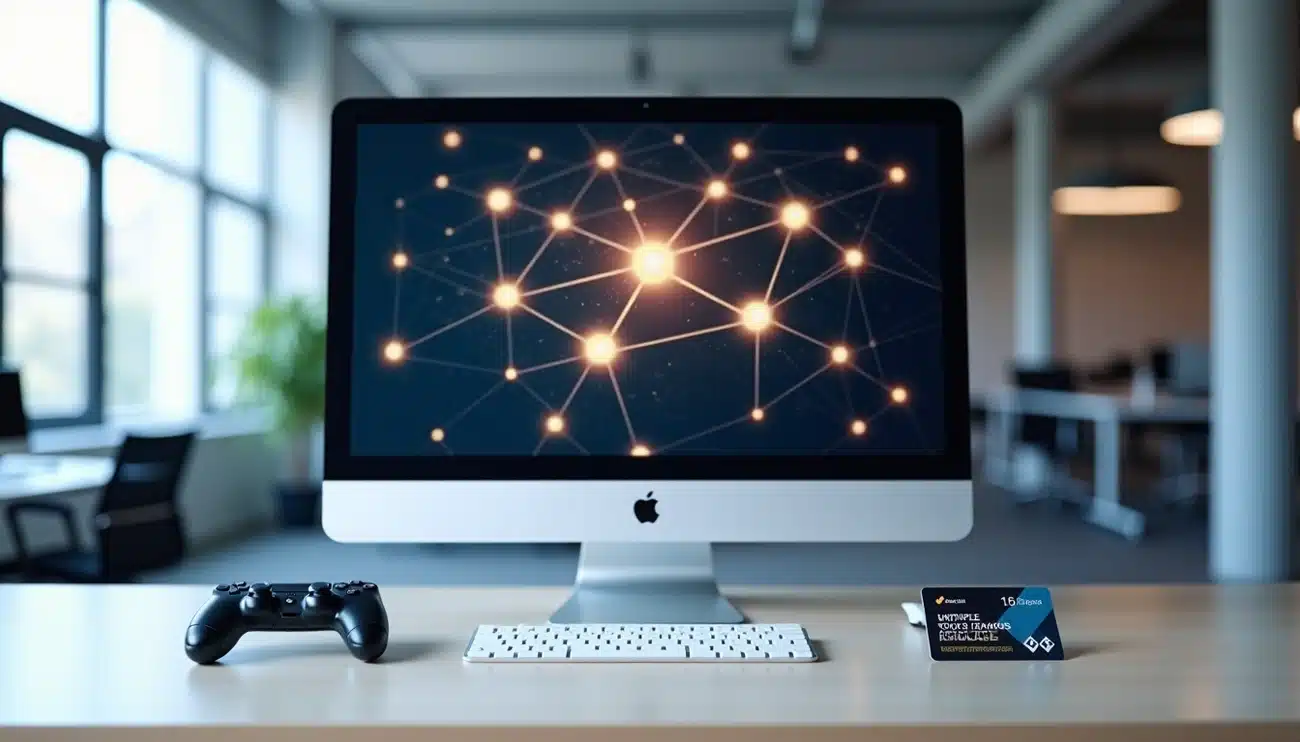Let's explore this fundamental concept of the blockchain world together. In fact, a utility token is a means of accessing services in a crypto ecosystem , and unlike a security token, it cannot really be considered as an asset . These tokens are mainly used as a payment method for services, to represent voting rights in certain ecosystems or as digital financial assets . Although the most widely used token standard for utility tokens, i.e. the ERC20 developed on the Ethereum network, other blockchains are also gaining ground. In this guide, we will clearly define what a utility token is, explore its uses and present concrete examples to help you understand its essential role in the blockchain ecosystem.
Definition of a utility token
Image Source: Medium
Definition of a utility token
A utility token is essentially a digital asset that gives its holder a right to use it in a specific ecosystem. Unlike other types of digital asset, this type of token is not primarily intended for investment, but rather for use within a decentralised platform.
What is a utility token?
The utility token works like a digital access key. It can be compared to a casino token or an arcade ticket - you buy it not for its intrinsic value, but for what it allows you to do. These tokens generally allow you to access certain functions of a decentralised application (dApp), pay transaction fees on a platform or participate in a specific service.
For example, if I were developing a decentralised storage application, I could create a utility token that would allow users to pay for storage space. This token would then have a concrete use within my ecosystem.
Difference between token and corner
Although often used interchangeably, "token" and "coin" represent two distinct concepts in the blockchain universe:
- CoinBitcoin: Has its own independent blockchain and functions primarily as a medium of exchange or store of value. Bitcoin and Ethereum are classic examples of coins.
- TokenExists on a pre-existing blockchain and has specific functionalities that go beyond the simple transfer of value.
A token therefore depends on an underlying blockchain platform to exist and function. Most utility tokens today are built on standards such as ERC-20 (Ethereum) or BEP-20 (Binance Smart Chain).
Why are utility tokens important?
Utility tokens play a fundamental role in the blockchain ecosystem for a number of reasons:
- They enable innovative projects to be financed via ICOs while creating a community of committed users.
- They create a circular economic model within a decentralised ecosystem
- They facilitate participatory governance by giving holders decision-making power
In addition, these tokens encourage the adoption of blockchain technologies by offering concrete and accessible use cases. They are the cornerstone of many modern decentralised applications, creating new business models that were not possible before the advent of blockchain technology.
Concrete examples of utility tokens
Image Source: tastylive
To better understand the utility token concept, let's take a look at some concrete examples that have proven their value in various sectors of the blockchain ecosystem.
Basic Attention Token (BAT)
The BAT is at the heart of the digital advertising revolution. This utility tokenises the attention economy within the Brave browser. Since its launch in 2017, BAT has reached tens of millions of users worldwide and almost 2 million verified creators [1]. Ranked as the 14th most distributed token on Ethereum in terms of holders, it is one of the most widely adopted tokens. [1].
BAT works on a simple but effective model: users are rewarded with BAT tokens when they view ads that respect their privacy. They can then use these tokens to support their favourite content creators on various platforms.
Chiliz (CHZ)
Chiliz (CHZ) is a perfect example of how a utility token can transform a traditional sector. This ERC20 and BEP-20 token, based on Ethereum and compatible with the Binance Smart Chain, connects the world of cryptocurrencies to that of sport. [2]. Its specific purpose is to buy Fan Tokens on the Socios.com [2].
These Fan Tokens allow fans to vote on certain decisions concerning their favourite team and access exclusive experiences such as attending matches as VIP guests or meeting players. [2]. For example, Cypriot club Apollon FC even allowed fans to choose the team formation for a friendly match. [2].
We have also developed our own utility token, the DRVL. To find out more about our token project, visit our dedicated platform : https://token.deravel.com
The Graph (GRT)
The Graph uses its GRT token as a central coordination element between data suppliers and consumers. This network relies on four types of participants: Delegators, Curators, Developers and Indexers [3]. The Delegators stake their TSOs with the Indexers to secure the network and in return receive a percentage of the request fees and indexing rewards. [3].
GRT's initial offering is 10 billion tokens, with a target annual issuance of 3% to reward Indexers. [3]. Approximately 1% of the supply is burnt each year through various activities on the network [3].
Chainlink (LINK)
LINK is the native utility token of Chainlink, a decentralised oracle network. It is an ERC-20 token with an additional ERC-223 function called "transfer and call", which facilitates interaction with smart contracts. [4].
This token fulfils several essential functions: it encourages the accuracy of data, maintains the stability of contracts and rewards nodes for their work in validating transactions. [4]. Chainlink is used by major institutions such as Swift, Euroclear and Mastercard, and has enabled transactions worth tens of trillions of dollars [5].
Utility tokens vs Security tokens
Image Source: Blockchain Council
The fundamental distinction between utility tokens and security tokens is crucial to understanding the blockchain ecosystem. These two categories of token differ radically in terms of their nature and regulatory framework.
Purpose and use
Utility tokens serve a specific purpose in a blockchain ecosystem, giving users access to particular services or preferential treatment. They make up the majority of tokens issued during ICOs. Security tokens, on the other hand, represent a share in the issuing company, and are designed as genuine investment vehicles.
Associated rights
Unlike security tokens, investors who buy utility tokens do not own a real stake in the company. Utility tokens do not generate any direct return, whereas security tokens potentially offer compensation linked to the asset they represent, similar to traditional shares. The value of a utility token depends solely on the demand for its utility, whereas the value of a security token is directly linked to the valuation of the issuing company.
Regulations and Howey test
The " Howey Test The "security token test" is the main tool for determining whether a token is a security token. This test, instituted by the US Supreme Court in 1946, defines an asset as a financial security if "a person invests his money in a common enterprise and expects profits to be generated solely by the efforts of the promoter or a third party". Security tokens are subject to securities regulations, offering increased protection against fraud, while utility tokens remain largely unregulated.
The role of utility tokens in the blockchain ecosystem
Image Source: Scribd
The role of utility tokens in the blockchain ecosystem
Utility tokens are the foundation of many blockchain projects, creating circular economies around decentralised services. Their impact goes far beyond the initial financing of a project.
Access to decentralised services
The primary role of a utility token is to act as an "access key" to a platform's services. As a user, I can access specific functionalities only by holding and spending these tokens. This method creates a self-sustaining business model where demand for the service naturally generates demand for the associated token.
Participation in governance
Utility tokens also enable users to play an active part in decisions concerning the development of the protocol. For example, holding tokens often gives users the right to vote on proposals for improvements. This mechanism, known as decentralised governance, ensures that the development of a project remains aligned with the interests of its community.
Rewards and incentives
Another essential aspect concerns incentive mechanisms. Blockchain projects frequently distribute tokens to reward behaviour that benefits the ecosystem, such as providing liquidity, validating transactions or creating content.
Impact on token value
Finally, the actual utility of a token directly influences its market value. The more functions a token offers and the more users it attracts, the more its demand and therefore its price tend to rise. This relationship creates a virtuous circle that benefits both users and developers.
Conclusion
Utility tokens are certainly one of the most important innovations in today's blockchain ecosystem. Their ability to create circular economies around decentralised services is transforming the way we interact with digital applications. Ultimately, what distinguishes a good utility token is its ability to solve a real problem while offering a concrete utility to its holders.
An analysis of examples such as BAT, Chiliz, The Graph and Chainlink shows us the diversity of possible use cases, ranging from digital advertising to sport, data infrastructure and oracles. Each of these tokens brings specific added value to its respective ecosystem, demonstrating the versatility of this concept.
Unlike security tokens, utility tokens do not represent a stake in the issuing company, but rather offer a right to use a service. This fundamental distinction also affects their regulatory treatment, an essential aspect for any investor or entrepreneur in this field to understand.
We also see utility tokens playing a crucial role in decentralised governance, enabling communities to actively participate in the decisions that shape the future of their favourite platforms. This participatory dimension is one of the major strengths of blockchain technology.
If you would like to see a concrete example of a utility token, we invite you to explore our DRVL project on our dedicated platform: https://token.deravel.com
So, far from being mere means of financing, utility tokens are emerging as structuring elements of the new digital economy. Their development will undoubtedly continue to redefine the way we interact with online services, while paving the way for ever more innovative and participative business models.
FAQs
Q1. What is the difference between a utility token and a security token? A utility token offers a right of use in a specific ecosystem, while a security token represents a financial stake in the issuing company. Utility tokens are generally not subject to securities regulations, unlike security tokens.
Q2. How are utility tokens used in decentralised governance? Utility tokens often enable holders to participate in decisions concerning the development of a blockchain project. For example, they can give holders the right to vote on proposals to improve the protocol, ensuring that development remains aligned with the interests of the community.
Q3. What are some concrete examples of utility tokens? Notable examples include the Basic Attention Token (BAT) used in the Brave browser advertising ecosystem, Chiliz (CHZ) for fan engagement in sport, and Chainlink (LINK) which powers a decentralised network of oracles.
Q4: How is the value of a utility token determined? The value of a utility token depends mainly on its usefulness and the demand for the services it provides. The more features a token offers and the more users it attracts, the more its demand, and therefore its price, tends to rise.
Q5. What role do utility tokens play in financing blockchain projects? Utility tokens are often issued during initial coin offerings (ICOs) to finance the development of blockchain projects. They enable companies to raise funds while creating a community of committed users who can use these tokens to access the platform's future services.
References
[1] – https://basicattentiontoken.org/
[2] – https://academy.youngplatform.com/fr/cryptomonnaies/chiliz-football-blockchain/
[3] – https://thegraph.com/docs/fr/resources/tokenomics/
[4] – https://coinmarketcap.com/academy/article/what-is-chainlink
[5] – https://chain.link/





